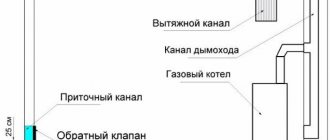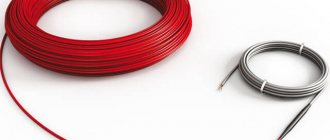The principle of operation of heating with natural circulation
For any water heating system to operate, it is necessary to ensure the circulation of coolant through the pipes. When heated in the boiler, hot water must flow into radiators and radiators to transfer heat to the premises of the house. A water heating system with natural circulation is no exception.
Heating scheme with natural circulation
The movement of the coolant occurs due to the difference in density in the normal and heated states. When a working boiler enters the heat exchanger, the water temperature increases and, as a result, the density decreases. Since the specific gravity of the cold coolant is higher, it begins to displace the heated one. As a result, mass movement is formed.
Before making water heating with natural circulation with your own hands, you should carefully read the technical characteristics and specifics of operation:
- High degree of reliability . The absence of moving elements (circulation pump impeller) and pressure equal to atmospheric pressure ensure long-term operation of the natural heating system of a private home;
- Inertia of the system . Natural circulation in a closed heating system is ensured by a small pressure difference. Therefore, the rate of hot water flow to the radiators will be minimal;
- Mandatory compliance with the slope of highways . For normal operation, the slope of the heating system with natural circulation must correspond to the calculated data. The pipes are installed with a slope away from the boiler, and for the return line - towards the boiler. This ensures optimal system operation.
It should also be noted that installation of a heating system with natural circulation is recommended for schemes with a pipeline length of no more than 30 m. Otherwise, a large volume of cooled coolant will significantly reduce its speed.
A traditional heating scheme for a two-story house with natural circulation may involve the installation of a gas, solid fuel or electric boiler. It is important that their design includes a protection system against overheating in the event of reverse movement of the coolant or air locks.
Types of coolant circulation
Based on the mode of movement, there are 2 main types of coolant circulation:
- Natural;
- Forced.
Natural circulation of the coolant is realized due to the difference in the densities of hot and cold water; the movement of water of this type requires a special design of the system and is implemented only in autonomous heating schemes for private houses. Forced circulation of the coolant has become much more widespread; the movement of the medium here is carried out using injection devices - circulation pumps; the scheme is universal and is used in both central and individual (autonomous) heating complexes. Next, we will consider in detail each type of circulation, the design features of systems with gravitational and forced movement of the coolant, the advantages and disadvantages of the schemes.
Heating schemes with natural circulation
First of all, it is necessary to choose the correct layout of pipelines, radiators and boiler. Since heating with natural circulation can be done correctly only according to a pre-drawn plan, maximum attention should be paid to this stage of the work.
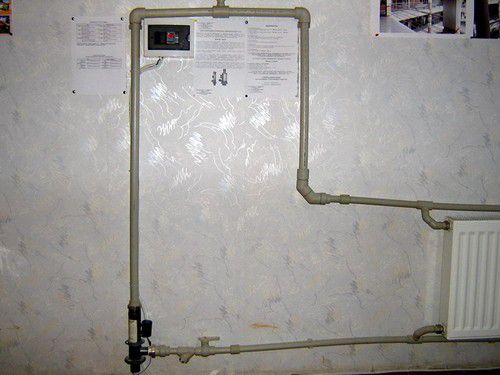
Heating with natural circulation in the apartment
At the first stage, a primary analysis of the room (house) where it is planned to install a heat supply system is carried out. The living area, the degree of thermal insulation of the external walls and the type of boiler for heating water are taken into account. Currently, there are many schemes with which you can make heating with natural circulation with your own hands. The most popular are:
- Single-pipe . The best option for small houses and apartments;
- Two-pipe . Selected to provide air heating in houses with medium and large areas, two-story buildings.
However, given the principle of operation of a heating system with natural circulation, one should remember the main limitations - the total length of the pipeline, the minimum number of rotary units. Therefore, this scheme cannot be used for manifold or tee pipe routing. Too large hydraulic losses will negatively affect the speed of movement of the coolant.
When calculating a heating system with natural circulation, it should be taken into account that only water can be used in this system. Antifreeze is too dense to provide adequate pressure in the pipelines.
Single pipe system
For small country houses and country houses, when calculating a heating system with natural circulation, not only technical (operational) characteristics are taken into account, but also the total cost of the project. The result should be a reliable and inexpensive heat supply system. Therefore, most often these houses have a single-pipe heating system with natural circulation.
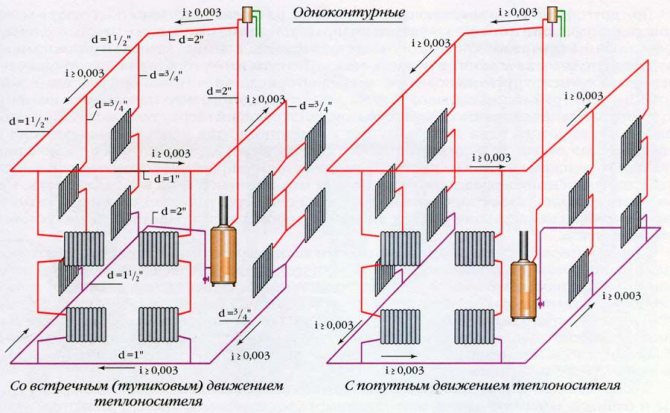
Single pipe heating system
A feature of this system is the presence of one highway. Radiators and batteries are connected to it in parallel, forming a single circuit. The main advantages of a single-pipe heating system with natural circulation are the minimum number of components, low material consumption and ease of installation. However, it must be taken into account that the cooling rate of the coolant in this system is quite high due to the sequential transfer of heat to each radiator in the circuit.
To optimize the thermal regime in the natural heating system of a private house, it is necessary to provide for the presence of the following components:
- Bypass in the piping of each radiator . It will make it possible to limit the flow of coolant into the battery without changing the parameters of the entire system. With its help, you can completely turn off the heating device for replacement or repair without stopping the heat supply;
- Battery-powered thermostats. They are installed in a heating system with natural circulation paired with a bypass. An automatic thermal element will change the cross-section of the flow diameter of the radiator pipe, thereby regulating the degree of heating of the device;
- Mayevsky crane . An essential component in the radiator piping. Since it is not always possible to accurately calculate a heating system with natural circulation, you should consider a system for removing air. This is exactly what the Mayevsky crane is designed for.
Another advantage of a single-pipe natural circulation heating system is its small footprint. The installation of the highway can be done either open or closed. It is only important to ensure that radiators are connected to it.
For a water heating system with natural circulation with one pipeline, the boiler and radiators can be located on the same level, which is prohibited for other schemes.
Two-pipe system
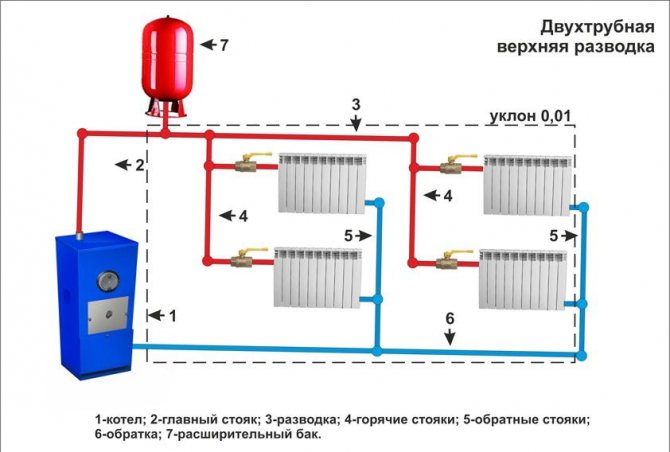
Two-pipe heating
Stable heating operation in medium and large houses can only be ensured by separating hot and cold water flows. In this case, the best option would be a two-pipe heating system with natural circulation.
For normal operation of the system, it is necessary to install the boiler below the level of the radiators. This is necessary to create pressure of cooled water, which creates natural circulation in a closed heating system. For better pressure, it is necessary to make an accelerating riser immediately after the boiler. An expansion tank is installed at its highest point. A spill pipe is mounted from it at an angle, to which radiators are connected.
A correctly calculated and installed two-pipe heating system with natural circulation will work even with a minimal temperature difference between the cooled and heated coolant. To implement such a project, the following nuances must be taken into account:
- placement of a water heating boiler with natural circulation. Most often it is located in the basement or basement. It is necessary to ensure normal temperature conditions, ventilation and natural lighting;
- Control pipe on the expansion tank . Even if you correctly calculate a heating system with natural circulation, there will still be a possibility of a critical decrease in the volume of water. Using the control pipe, you can monitor this indicator;
- Water replenishment and drainage units . They are located at the lowest point - on the return pipe. In order to properly make heating with natural circulation, you should provide in advance for methods of automatic (semi-automatic) replenishment of the system, as well as prompt drainage of water.
Thanks to the emergence of new materials, you can make a two-pipe heating system with natural circulation with your own hands from steel or polymer pipes. It all depends on the budget, availability of appropriate tools and materials.
In a two-pipe heating system with natural circulation, the installation of bypasses is not necessary. It is only important to provide for the installation of shut-off valves for possible disconnection of the device from the public main.
Heating with wiring on top - varieties
If a household or building includes floors, then a separate horizontal circuit is created on each floor, connected to vertical risers.
It will be 0.1 m. In this scheme, each of the batteries is equipped with two separate pipes: water inlet and outlet. Systems with forced and natural circulation These types differ in that, firstly, there is an electric pump that forces the coolant to move, and secondly, circulation occurs on its own, obeying physical laws.
Only then will the house be guaranteed to be warm and cozy. The pipe from the boiler rises to the top point of the system, where the horizontal section begins - it is made at an angle. In general, a system with top wiring is quite viable, and with proper calculations, it is also very effective.
First of all, the speed of fluid movement increases, due to which the building warms up much faster. The heat supply to the batteries is adjusted using taps and the temperature is observed to remain stable for one to two days. Vertical wiring with bottom connection of pipes When laying out the heating route in a multi-storey building using a two-pipe heat supply scheme with vertical connection of supply and return, the bottom connection will work better due to the reasons listed above, or more precisely: At the supply, the temperature of the working fluid will always be higher than at the pipe reverse; In pipes connected according to this scheme, a fairly high pressure is created, which increases as the number of floors increases.
Types of two-pipe systems
For this reason, they have to be equipped with descenders. It is possible to install an open tank, but it must be at the highest point of the system, that is, in the attic. Due to this, colder and therefore dense water gradually displaces the heated liquid upward. There is no clear answer to the question of what would be better: a single-pipe or two-pipe heating system.
This ensures normal coolant circulation in the pipeline, and therefore the efficient operation of such a design. Vertical wiring is used in traditionally built houses, while horizontal wiring is used in buildings with an open floor plan.
It should be noted that the two-pipe heating system with bottom wiring requires the installation of Mayevsky taps. Typically, lines laid from above are placed in the attic space, and if there is no space, under the ceiling of the top floor. The cooled coolant from the radiators flows through the return line into the pipeline and into the boiler. Radiators are connected with a pipe with a diameter equal to the inlet pipe of the heat exchanger.
The advantage is the absence of air pockets. It will set the speed of movement of the coolant in the heating circuit and the effectiveness of the entire heating. Thus, it prevents equipment breakdowns as a result of sudden overloads. Installing such a system in a garage is not necessary, but it would be absolutely useful, since it is very difficult to work here in winter: the engine does not start, the oil freezes, and it is simply uncomfortable to work with your hands. Some of them are the price of the circulation pump, as well as the cost of the fittings that are necessary for its normal functioning. TICHELMAN LOOP - associated TWO-PIPE heating system
Calculation of heating power with natural circulation
To calculate the basic parameters of heat supply, it is recommended to use specialized programs. With their help, you can calculate a heating system with natural circulation as accurately as possible. But if this is not possible, other, simplified methods are used.
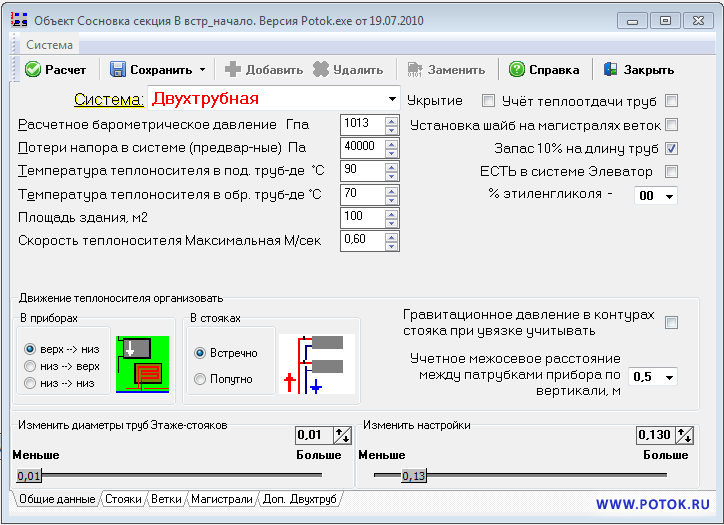
Heating calculation program
The easiest way is to calculate the required boiler power using the ratio of 1 kW of thermal energy per 10 m² of area. In this case, the obtained result must be multiplied by a coefficient that depends on the climatic conditions of the region.
Its values for a water heating system with natural circulation are given in the table. These coefficients are recommended and may be replaced by others depending on the actual characteristics of the house. But in any case, this method will allow you to determine the approximate parameters of the heating system. Therefore, its use is a mandatory step in the design of heat supply.
| Region | Correction factor |
| South of Russia | From 0.7 to 0.9 |
| Middle lane | From 1 to 1.3 |
| Northern regions | From 1.4 to 2 |
However, this does not take into account the degree of thermal insulation of the building, the number and characteristics of window and door structures. Therefore, it is best to use another method for calculating a heat supply system with natural circulation. Calculation stages:
- 1 m³ of residential building will require 400 W of heat. By multiplying the power by the volume of the building, we obtain the initial value of thermal energy.
- To compensate for heat losses through windows, we multiply the number of structures by 100 W. The same technique is used for external doors, but with compensation of 200 W per each.
- If the room has an external wall, then for normal operation of the natural heating system of a private house, the result is multiplied by a correction factor of 1.2.
- For private houses, heat losses through the roof and floor are taken into account using a coefficient of 1.5.
It should be noted that even this calculation will be approximate. When planning the installation of heating with natural circulation with your own hands for a large house, it is recommended to contact specialists to accurately calculate the main characteristics of the system.
To minimize heat losses in a building, good thermal insulation of external walls, ceilings, and roofs is necessary. This will reduce the ongoing costs of DIY natural circulation water heating.
Rules for drawing up a heating scheme with natural circulation
Knowing the basic principles of operation of a heat supply system with natural circulation and choosing the optimal scheme, you can begin to assemble it. This stage is no less important than the previous ones, since further heating operation will depend on the technical parameters of the components.
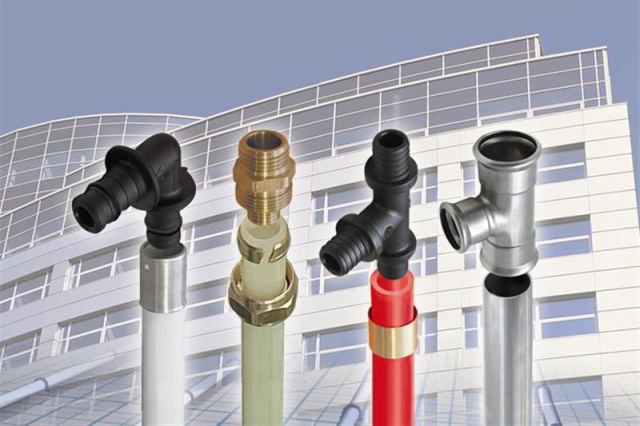
Heating pipes
It is necessary to take into account all the features of this system. In schemes with forced circulation, compensation of hydraulic losses occurs due to the operation of the circulation pump. For systems with natural circulation in closed heating, such a mechanism does not exist. Therefore, to minimize losses, you should pay attention to the following points in the design and selection of components:
- Heating pipes . Their diameter should be from DN32 to DN40. This compensates for the friction of water on the inner surface. It is also recommended to choose polymer products with a smooth wall. Their actual outer diameter is from 40 to 50 mm;
- Highway routing diagram . It is necessary to avoid rotating units that increase hydraulic resistance in the system;
- Height of the accelerating riser . In a heating scheme for a two-story house with natural circulation, it should be higher than the ceiling of the second floor. The expansion tank is located in the attic;
- Characteristics of shut-off valves . Its presence should not affect the system parameters.
To better understand the operating principles of the heating circuit of a two-story house with natural circulation, an analogy can be drawn with well-known communicating vessels. In this case, the boiler will be located below the level of the radiators, therefore the liquid flow will circulate in its direction. That is why when developing a diagram and installing a heating system with natural circulation, it must be located as low as possible.
To prevent changes in water flow, a special valve is installed on the return pipe. This phenomenon may occur when the system is first started, when the difference in coolant temperatures is small.




